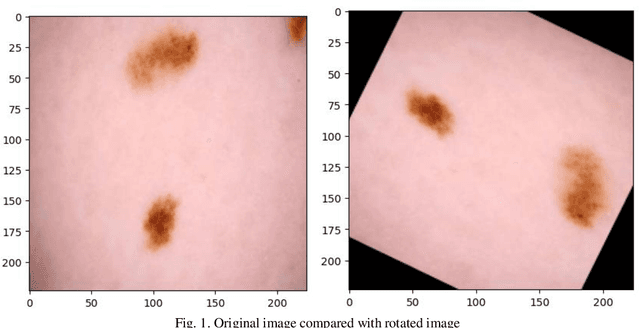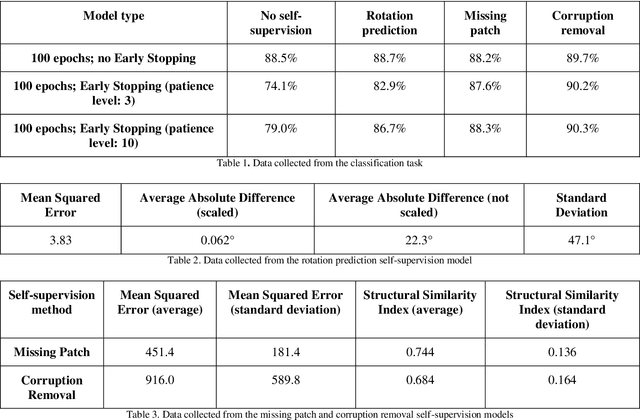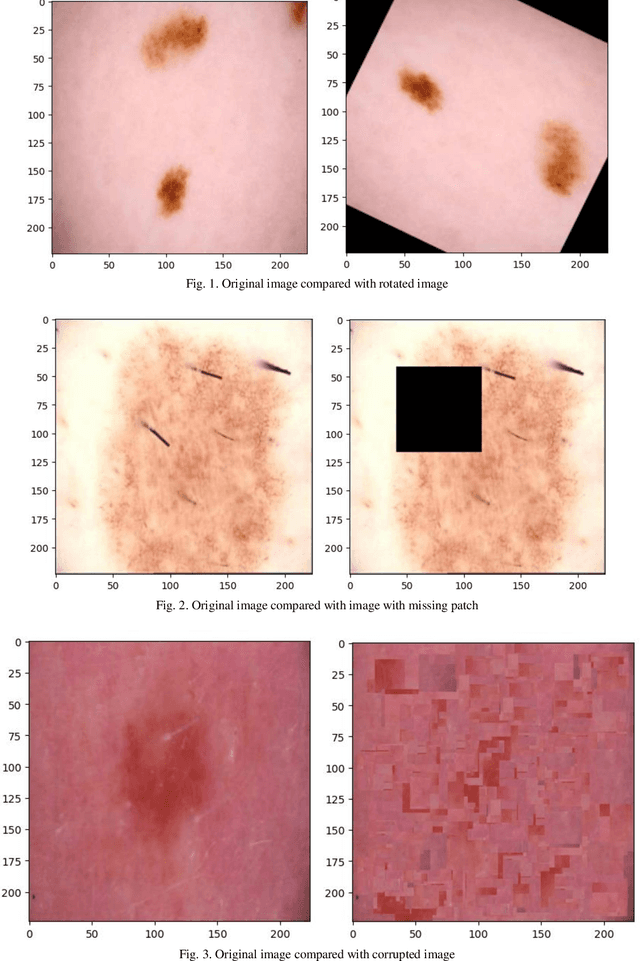Suraj Rajendran
Advancing Melanoma Diagnosis with Self-Supervised Neural Networks: Evaluating the Effectiveness of Different Techniques
Jul 19, 2024


Abstract:We investigate the potential of self-supervision in improving the accuracy of deep learning models trained to classify melanoma patches. Various self-supervision techniques such as rotation prediction, missing patch prediction, and corruption removal were implemented and assessed for their impact on the convolutional neural network's performance. Preliminary results suggest a positive influence of self-supervision methods on the model's accuracy. The study notably demonstrates the efficacy of the corruption removal method in enhancing model performance. Despite observable improvements, we conclude that the self-supervised models have considerable potential for further enhancement, achievable through training over more epochs or expanding the dataset. We suggest exploring other self-supervision methods like Bootstrap Your Own Latent (BYOL) and contrastive learning in future research, emphasizing the cost-benefit trade-off due to their resource-intensive nature. The findings underline the promise of self-supervision in augmenting melanoma detection capabilities of deep learning models.
Nanorobotics in Medicine: A Systematic Review of Advances, Challenges, and Future Prospects
Sep 19, 2023Abstract:Nanorobotics offers an emerging frontier in biomedicine, holding the potential to revolutionize diagnostic and therapeutic applications through its unique capabilities in manipulating biological systems at the nanoscale. Following PRISMA guidelines, a comprehensive literature search was conducted using IEEE Xplore and PubMed databases, resulting in the identification and analysis of a total of 414 papers. The studies were filtered to include only those that addressed both nanorobotics and direct medical applications. Our analysis traces the technology's evolution, highlighting its growing prominence in medicine as evidenced by the increasing number of publications over time. Applications ranged from targeted drug delivery and single-cell manipulation to minimally invasive surgery and biosensing. Despite the promise, limitations such as biocompatibility, precise control, and ethical concerns were also identified. This review aims to offer a thorough overview of the state of nanorobotics in medicine, drawing attention to current challenges and opportunities, and providing directions for future research in this rapidly advancing field.
Applications of machine Learning to improve the efficiency and range of microbial biosynthesis: a review of state-of-art techniques
Aug 26, 2023Abstract:In the modern world, technology is at its peak. Different avenues in programming and technology have been explored for data analysis, automation, and robotics. Machine learning is key to optimize data analysis, make accurate predictions, and hasten/improve existing functions. Thus, presently, the field of machine learning in artificial intelligence is being developed and its uses in varying fields are being explored. One field in which its uses stand out is that of microbial biosynthesis. In this paper, a comprehensive overview of the differing machine learning programs used in biosynthesis is provided, alongside brief descriptions of the fields of machine learning and microbial biosynthesis separately. This information includes past trends, modern developments, future improvements, explanations of processes, and current problems they face. Thus, this paper's main contribution is to distill developments in, and provide a holistic explanation of, 2 key fields and their applicability to improve industry/research. It also highlights challenges and research directions, acting to instigate more research and development in the growing fields. Finally, the paper aims to act as a reference for academics performing research, industry professionals improving their processes, and students looking to understand the concept of machine learning in biosynthesis.
Patchwork Learning: A Paradigm Towards Integrative Analysis across Diverse Biomedical Data Sources
May 13, 2023Abstract:Machine learning (ML) in healthcare presents numerous opportunities for enhancing patient care, population health, and healthcare providers' workflows. However, the real-world clinical and cost benefits remain limited due to challenges in data privacy, heterogeneous data sources, and the inability to fully leverage multiple data modalities. In this perspective paper, we introduce "patchwork learning" (PL), a novel paradigm that addresses these limitations by integrating information from disparate datasets composed of different data modalities (e.g., clinical free-text, medical images, omics) and distributed across separate and secure sites. PL allows the simultaneous utilization of complementary data sources while preserving data privacy, enabling the development of more holistic and generalizable ML models. We present the concept of patchwork learning and its current implementations in healthcare, exploring the potential opportunities and applicable data sources for addressing various healthcare challenges. PL leverages bridging modalities or overlapping feature spaces across sites to facilitate information sharing and impute missing data, thereby addressing related prediction tasks. We discuss the challenges associated with PL, many of which are shared by federated and multimodal learning, and provide recommendations for future research in this field. By offering a more comprehensive approach to healthcare data integration, patchwork learning has the potential to revolutionize the clinical applicability of ML models. This paradigm promises to strike a balance between personalization and generalizability, ultimately enhancing patient experiences, improving population health, and optimizing healthcare providers' workflows.
 Add to Chrome
Add to Chrome Add to Firefox
Add to Firefox Add to Edge
Add to Edge